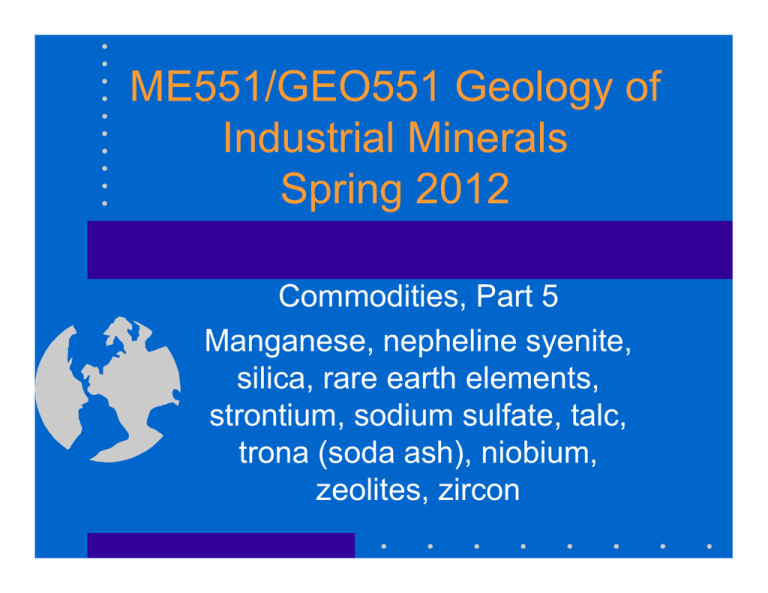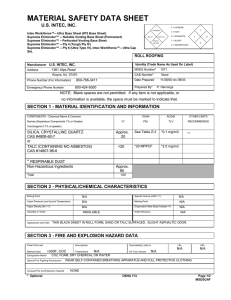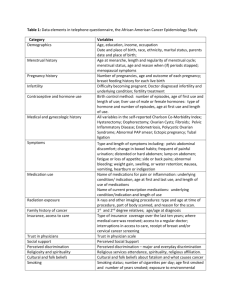ME551/GEO551 Geology of Industrial Minerals Spring 2012
advertisement

ME551/GEO551 Geology of Industrial Minerals Spring 2012 Commodities, Part 5 Manganese, nepheline syenite, silica, rare earth elements, strontium, sodium sulfate, talc, trona (soda ash), niobium, zeolites, zircon Schedule • Field reports due April 30 • NMGS Spring meeting April 27, Macey Center • commodities presentation by students on May 7 • project presentations on May 7 • Final and project report due May 10 Manganese Introduction • Manganese (Mn) was discovered by Scheele and isolated by Gahn in 1774 • A silver–gray metal, resembling iron but harder and more brittle • Forms 0.09% of earth’s crust • Atomic Number : 25 • Relative Atomic Mass : 55 • Melting Point : 1245oC • Boiling Point : 2150oC • Relative Density : 7.43 www.theodoregray.com/ • Hardness on Mohs scale: 5.0 PeriodicTable/Elements/027/ http://www.ucc.ie/ucc/depts/chem/dolchem/html/elem/elem025.html Manganese Minerals • Mn does not occur in nature as a native metal, but in over 100 minerals including, oxides, carbonates and silicates Industrial Minerals and Rocks Commonly Mined Mn Minerals Pyrolusite (MnO2) Rhodochrosite (MnCO3) Psilomelane [(BaH2O)2Mn5O10] http://mineral.galleries.com/minerals/ Geology of Mn ores • Occurs worldwide in various geological environments • Two major types of economic Mn ore deposit – Sedimentary deposits – Residual deposits • Minor type of ore deposit – Metamorphic deposits Geology of Mn ores • Sedimentary deposits – the most common, usually stratiform or lenticular. Formed by chemical processes during the deposition of marine sediments. Contain manganese oxides and carbonate minerals, interbedded together or with limestone or shale • Residual deposits – formed by alteration of existing manganese deposits or by concentration of the manganese minerals when other minerals are washed away by weathering or ground water processes • Metamorphic deposits – regionally metamorphosed sedimentary or residual deposits, occurring in marbles, slates, quartzites, schists, and gneisses Manganese Nodules • Potato-size chunks of Mn mixed with Fe, Ni, Co and other useful metals • Exist in deep ocean floors: e.g., at depths between 14,000ft and 17,000ft in the Pacific ocean • Deep Ocean Mining Project – Howard Hughes built Glomar Explorer at a cost of over $200 mil, funded by CIA, to retrieve a Soviet submarine on June 20, 1974. – The Soviet Golf-II Class ballistic missile submarine had sunk on April 11, 1968, ~750 miles northwest of Hawaii – (Miners News, Vol. 20, Issue 1) • Manganese nodules have not been mined yet www.theodoregray.com/ PeriodicTable/Elements/02 7/ http://www.fas.org/irp/program /collect/jennifer.htm Major World Mn Deposits Nikopol, Ukraine and Tchiatoura, Russia S. Appalachian, U.S. Franklin, NJ Nsuta, Ghana Moanda, Gabon Amapa, Brazil Kalahari, S. Africa Sedimentary http://www.mapquest.com/atlas/?region=world Residual Groote Elyandt, Australia Metamorphic Major Mn deposits in USA Cuyuna iron range, MN Chamberlain, SD Three Kids, NV Artillery Mountain, AZ S. Appalachian; Shenandoah Valley, VA, via Cartersville, GA, to AL Batesville, AR http://www.aphis.usda.gov/vs/nahps/approved_markets/usa-map-bw.jpg Mn Minerals Production Manganese Flow Sheet Adopted from Jones (1994) Uses of Manganese • Manufacture of steel and other important alloys – Mn removes impurities such as sulfur and oxygen and improves rolling and forging qualities as well as strength, toughness, and durability in steel • Depolarizer in dry cells • Pigments, glazes, colors, paint dryers and preservatives • As a catalyst and laboratory reagent, e.g., potassium permanganate Uses of Manganese • Enzymes for the metabolism of fats and proteins • Food supplement – To regulate blood sugar levels and support the immune system – To aid bone development and reproduction – To provide vitamin K and the B-complex group • Dry feeds for cattle, pigs, & poultry – It helps to prevent breeding complications in cattle, ensures optimum growth for pigs, and aids hatchability and shell quality in poultry • Fertilizers and fungicides Nepheline syenite Nepheline syenite • light-colored, silica-deficient feldspathic igneous rock • sodium and potassium feldspars • nepheline, no quartz • not mined in US but in Canada Nepheline syenite—properties • In glass, alumina from nepheline syenite improves product hardness, durability, and resistance to chemical corrosion • in ceramics, nepheline syenite is used as a flux, melting at an early stage in the firing process and forming a glassy matrix that bonds together the other components of the system Nepheline syenite • alumina acts as a matrix of stabilizser, enhancing the workability of molten glass, and increasing the resistance for scratching, breaking and chemical protection • alkali acts as a flux agent, lowering the melting temperature of the batch (no need for soda ash) Uses • Glass • Ceramics • Fillers, extenders, paint, coatings, roofing granules • Dimension stone, aggregate, abrasive • Alumina source – Russia produces most of its alumina from nepheline syenite Silica Silica • • • • • • • • • • • Quartz Citrine—yellow to brown color, similar to topaz Tridymite Cristobalite Coesite Stishovite Melanophlogite Lechatelierite Agate—banded, multicolored Flint—gray to black, opaque Chalcedony—fine grained chert – Carnelian—red to reddish brown Silica—introduction • • • • • • SiO2 industrial sand and gravel silicon quartz crystals special silica stone products tripoli (microcrystalline silica) – rottenstone • novacullite (whetstones, microcrystalline silica) • spiculite http://minerals.usgs.gov/minerals/pubs/commodity/silica/780292.pd f Industrial sand and gravel—introduction • • • • Silica silica sand quartz sand sand and gravel with a high SiO2 content Industrial sand and gravel—uses • glassmaking sand, 38% • foundry sand, 22% (molds, cores, castings) • abrasive sand, 5% • hydraulic fracturing sand, 5% • 30% for other uses (flux) not more than 0.6% iron oxide USGS Commodity Reports Industrial sand and gravel—uses • Glassmaking (high specifications, no Fe) • foundry (98% SiO2, low CaO, MgO, grain size and shape) • abrasive, blasting sand (clean metal, concrete’ angular shape) • hydraulic fracturing (frac) applications (well rounded) • ceramics • chemicals • ground silica (fillers, extenders; bright, reflective) • filtration (pure) • roofing granules • flux • optical fiber Industrial sand and gravel—regions USGS Commodity Reports Industrial sand and gravel—regions USGS Commodity Reports USGS Commodity Reports Industrial sand and gravel—geology • Sedimentary, especially where multiple cycles of erosion and deposition has upgraded the deposits – What geologic environments are we looking at? Silica sand—geology • White Maddi sand is used in foundries, filters, and glass products, Gabal El Kahshab near Maadi, Cairo Industrial sand and gravel—substitutions • For glass, foundry, molding – Zircon – olivine – staurolite – chromite sands Silicon Silicon—introduction • Silicon metal and alloys • Ferrosilicon Silicon—uses • • • • • ferrous foundry steel industries aluminum and aluminum alloys chemical industry semiconductor industry, which manufactures chips for computers from high-purity silicon Silicon—substitutions • ferrosilicon – aluminum – silicon carbide – silicomanganese • semiconductors and infrared – gallium arsenide – germanium Silicon—production USGS Mineral Yearbooks Silicon—production • • • • Norway, 27% South Africa, 15% Russia, 11% Canada, 10% USGS Mineral Yearbooks Quartz crystal Quartz crystal—introduction • • • • Hardness 7 any color common mineral cultured quartz crystals became important in 1971, no natural production Quartz crystal—properties • Piezoelectric effect • when compressed or bent, it generates a charge or voltage on its surface • if a voltage is applied, quartz will bend or change its shape very slightly • hardness • high electrical resistance • dimensional stability Growing quartz crystal • Process in Germany 50 years ago • grown in pressure vessels containing quartz dissolved in an aqueous alkaline solution at temperatures of 375 degrees centigrade and pressures of 800 to 2000 atmospheres • Seed crystals are placed near the top of the container • nutrient in the form of broken chunks of natural Brazilian quartz (lascas) as a nutrient are placed on the bottom • Convection currents move dissolved material from the bottom of the chamber to the cooler upper section where it deposits on the seed crystals http://www.itme.edu.pl/z18/syn... http://www.corningfrequency.com/library/qcao.html Quartz crystal—uses • • • • single-crystal silica Electronic applications optical applications filters, frequency controls, and timers in electronic circuits • carvings • gem stone Quartz crystal—geology • Pegmatites • in Arkansas veins filled cavities or fractures in the Crystal Mountain and Blakely Sandstones – 5 feet long and weighing over 500 pounds and clusters up to 15 feet long by 10 feet wide, weighing over 10 tons – end of the Ouachita Mountain orogenic cycle in Late Pennsylvanian to Early Permian (Ar/Ar) Quartz—production USGS Commodity Reports Special silica stone products Special silica stone products—introduction • abrasive tools – deburring media – grinding pebbles – grindstones, hones, – oilstones – stone files – tube-mill liners – whetstones • Fillers • extenders • flux Special silica stone products—introduction • • • • Sandstone quartzite vein quartz silica pebble • novaculite • microcrystalline quartz • speculite • tripoli • tripolite or diatomaceous earth • amorphous silica Novaculite • • • • • Sedimentary microcrystaline quartz homogeneous more compact than porous tripoli whetstones dense, hard, white to grayish-black in color, translucent on thin edges, and has a dull to waxy luster • resistant to erosion, it forms prominent ridges • Dev to Miss Novaculite Formation in Ark – 250-900 ft thick Rottenstone • Common variety of tripoli • Penn--weathering of siliceous shale Spiculite • Siliceous sponge spicules • replacement of spicule-bearing limestone • Texas Tripoli • • • • • • • • 1 to 10 micrometers 98% to 99% silica, minor Al and Fe white to cream brown red yellow abrasive diatomaceous earth (different origin) Tripoli—geology • alteration of chert, chalcedony, or novaculite, or leaching of highly siliceous limestones • Paleozoic chert bearing limestones in Arkansas and Oklahoma, Illinois – NE Ar cherty limestones of the Boone Formation (Mississippian) – Ouachita Mountains leaching of a limy phase within the Upper Division of the Arkansas Novaculite • Arkansas tripoli is >99% SiO2 Special silica stone products—source • Arkansas • Wisconsin Special silica stone products—uses • • • • Craft household industrial leisure uses Special silica stone products USGS Commodity Reports Environmental regulations of quartz • regulation of crystalline silica – hours workers exposure – water well monitoring – noise and dust control – water discharge – archaeological surveys – carcinogen Rare earth elements Rare earth elements—introduction • Lanthanide Series – – – – – – – – – – – – – – – Lanthanum Cerium Praseodymium Neodymium Promethium Samarium Europium Gadolinium Terbium Dysprosium Holmium Erbium Thulium Ytterbium Lutetium scandium Yttrium • Actinide Series – – – – – – – – – – – – – – – Actinium Thorium Protactinium Uranium Neptunium Plutonium Americium Curium Berkelium Californium Einsteinium Fermium Mendelevium Nobelium Lawrencium Rare earth elements—uses • • • • • • permanent magnets, 16% automotive catalytic converters, 22% glass polishing and ceramics, 39% petroleum refining catalysts, 12% metallurgical additives and alloys, 9% rare-earth phosphors for lighting, televisions, computer monitors, radar, and x-rayintensifying film, 1% • miscellaneous, 1% – NiMH batteries – flints for lighters Rare earth elements—uses • Phosphors (including pigments) largest growing sector – TVs – computer screens – energy-efficient tricolour lamps Toyota Prius 2.2 lbs Nd in magnets 22-33 lbs La in batteries http://www.molycorp.com/hybrid_ev.asp • • • • • • • • • • • • • • • • Aluminum Cadmium Chromite Coal Cobalt Copper Gold Iron Lead Lithium Manganese PGM Nickel Silica Tungsten Zinc http://www.reitausa.org/storage/Challenges%20Facing%20New% 20Global%20Rare%20Earth%20Separation%20Plants pdf Rare earth elements—import sources • Bastnaesite (Ce, La, Y)CO3F – China, California • Monazite (Ce, La, Th, Nd, Y)PO4 – Australia, 67% – France, 33% • Rare-earth metals, compounds, etc.: – China, 74% – France, 21% – Japan, 3% – United Kingdom, 1% IRON OXIDE COPPER-GOLD DEPOSITS (U, REE, PGM, Ni) http://pubs.usgs.gov/of/2007/1155/of2007-1155_map.pdf Mining districts and areas in New Mexico that contain REE deposits Mines and prospects in the Gallinas Mountains, Lincoln County Geologic map of the Gallinas Mountains, Lincoln and Torrance Counties, New Mexico (modified from Kelley et al., 1946; Kelley, 1949, 1971; Perhac, 1961, 1970; Woodward and Fulp, 1991; Schreiner, 1993; field reconnaissance by the author). Aeromagnetic map of the Gallinas Mountains area, from Kucks et al. (2001). Mineral zoning in the Gallinas Mountains, Lincoln County http://un2sg1.unige.ch/athena/... Monazite http://mineral.galleries.com/m... Apatite http://mineral.galleries.com/m... Rare earth elements—production USGS Mineral Yearbooks 100 90 80 Production, Kilotons 70 60 50 China 40 30 20 United States Australia 10 0 1983 Other 1988 1993 1998 2003 Rare earth elements—mineralogy • Bastnaesite LnFCO3 • Apatite > 5400 ppm total REE Ca5(PO4)3(OH,F,Cl) • monazite 500,000 ppm total REE (Ln,Th)PO4 • manganese nodules 99,000ppm total REE Rare earth elements—geology • • • • • Carbonatites pegmatites Monazite sand veins Cretaceous heavy-mineral beach sandstones • sea floor manganese nodules Beach placer sandstone deposits are tabular, stratabound REE-TiNb-Zr-Th (U) deposits. Strontium Strontium—introduction • Sr • 15th abundant element • does not occur naturally as an element, in compounds • No production in the United States since 1959 • celestite or celestine SrSO4 (same structure as barite) 56.4% Sr • strontianite SrCO3, 70.1% Sr Celesitite http://www.zeuter.com/~tburden Strontianite http://www.zeuter.com/~tburden Strontium—uses • faceplate glass of color television picture tubes, 77% • ferrite ceramic magnets, 8% • pyrotechnics and signals, 9% – fireworks (red flame) – flares • other applications, 6% – refining zinc – optical materials Strontium—production USGS Mineral Yearbooks Strontium—geology • association with rocks deposited by the evaporation of sea water (evaporites) • igneous rocks Sodium sulfate—introduction Sodium sulfate—introduction • • • • • disodium sulfate (Na2SO4), inorganic chemical Thenardite Na2SO4 Hanksite Na22K(SO4)9(CO3)2Cl Glauberite Na2Ca(SO4)2 Sodium sulfate—uses • • • • • • soap and detergents, 46% textiles, 12% pulp and paper, 13% glass, 11% carpet fresheners, 7% miscellaneous, 11% Sodium sulfate USGS Mineral Yearbooks Sodium sulfate—reserves • • • • • • • Botswana China Egypt Italy Mongolia Romania South Africa USGS Mineral Yearbooks Sodium sulfate—geology • brines or crystalline evaporite deposits • 10 ft thick deposit 1400 ft below the surface near Green River, Wyoming • Searles and Owens Lakes in California – 450 million tons of sodium sulfate resource • Great Salt Lake, Utah – 400 million tons of resource Sodium sulfate—byproduct • byproduct from the production of ascorbic acid, boric acid, cellulose, chromium chemicals, lithium carbonate, rayon, resorcinol, and silica pigments Glauberite http://mineral.galleries.com/m... Searles Lake http://www.bovagems.com/eclectic/HTML/19971001_1097BOVA2.html Talc Introduction Talc is an important industrial mineral, it is a vital part of everyday life. It can be found in: • the magazines; • the polymers in our cars and houses; • the paints • the tiles we walk on 9 Talc has high heat and chemical resistance, good electrical insulating properties, and improves stiffness and tensile strength, making it useful for use in the plastics and rubber industries. 9 Low electrical conductivity and acids make it an ideal surface for lab counter tops and electrical switchboards. It is also an important filler material for paints, rubber and insecticides. It is most known as the primary ingredient in talcum powder. Mineralogy Talc is a hydrated magnesium sheet silicate, Mg3Si4O10 (OH)2. Its elementary sheet is composed of a layer of magnesium-oxygen/hydroxyl octahedra, sandwiched between two layers of silicon-oxygen tetrahedra. MORPHOLOGY The size of an individual talc platelet can vary from approximately 1 micron to over 100 microns depending on the deposit. It is this individual platelet size that determines a talc’s lamellarity. The elementary sheets are stacked on top of one another, like flaky pastry, and, because the binding forces linking one elementary sheet to its neighbors are very weak, the platelets slide apart at the slightest touch, giving talc its characteristic softness. Macro-crystalline talc Micro-crystalline talc ¾ Mineral specimens are not very common as it does not form very large crystals ¾ It often replaces other minerals on an atom by atom basis and forms what are called pseudomorphs (false shape). The talc takes the form of the mineral it replaces. A specimen of what looks like milky quartz is quite a surprise when it not only has a soapy feel but can be scratched by a fingernail. Geology Talc is one of the common minerals in metamorphic rock. Although talc deposits can be found throughout the world in various geological contexts. Economically viable concentrations of talc are not that common. Best field indicators are softness, color, soapy feel, luster and cleavage. Talc deposits result from the transformation of existing rocks under the effect of hydrothermal fluids carrying one or several of the components needed to form the mineral (MgO, SiO2, CO2). The size and shape of talc deposits depend upon: 9the intensity of the hydrothermal activity; 9Pressure and deformations; Types of talc deposit Magnesium carbonate derivative orebodies The talc results from the transformation of carbonates (dolomite and magnesite) in the presence of silica. Deposits of this kind represent some 60% of world production and provide some of the whitest and purest talc ores. The Yellowstone (Montana, USA) and Respina (North-West Spain) talc deposits are good examples. Yellowstone mine in Montana - US Types of talc deposit Serpentinite derivative orebodies About 20% of present world production comes from the transformation of serpentinite into a mixture of talc and reactional magnesium carbonates. This ore, commonly called "soapstone", is always grey and never pure. To be used as an industrial mineral, it is often upgraded by flotation to increase the talc content and whiteness. This type of deposit is relatively common and widely distributed along ultramafic rock belts. In Vermont (USA), Quebec and Ontario (Canada) and Finland are deposits currently being worked. Argonaut mine in Vermont - US Types of talc deposit Siliceous or silico-aluminous rock derivative orebodies Results from the transformation of siliceous rocks. Magnesium is brought by the migration of hydro-thermal fluids. If the parent rock has a silico-aluminous composition, e.g. pelitic schist or gneiss, and under the same conditions of formation, chlorite can be formed in addition to the talc, the resulting ore being a mixture of both talc and chlorite. This type of deposit can be found in association with the magnesium-carbonate derivative type, this kind of deposit represents about 10% of world production. Trimouns mine, French Pyrenees • • • • • • • • • • • PHYSICAL CHARACTERISTICS Color is green, gray and white to almost silver. Luster is dull to pearly or greasy. Transparency crystals are translucent and masses are opaque. Crystal System is monoclinic. Crystal Habits: flattened tabular crystals with a hexagonal cross-section, usually talc is found in compact or lamellar masses. Forms pseudomorphs (false shape) of other crystals such as quartz, pyroxenes, olivines and amphiboles. Cleavage is perfect in one direction, basal. Fracture is uneven to lamellar. Hardness is 1 Specific Gravity is 2.7 - 2.8 (average) Streak is white. Associated Minerals include serpentine, dolomite, magnesite, quartz, pyroxenes, olivine, biotite and amphiboles. USES ¾Agriculture and Food ¾Ceramics ¾Coatings ¾Paper ¾Personal Care ¾Plastics ¾Rubber ¾Wastewater treatment Substitutes The major substitutes for talc are: clays and pyrophyllite in ceramics; kaolin and mica in paint and rubber; kaolin in paper; clays and mica in plastics. • Notable Occurances: include many mines up and down the Appalachian Mountains and in California and Texas, USA; Germany; Florence, Italy; Tyrol, Austria; Transvaal, South Africa and Shetland, Scotland. Mining Methods Overburden removal Most talc deposits are open-pit mines. The waste rock covering the talc vein is removed using shovels. Talc extraction The exposed talc is then extracted using shovels. Even at this early stage, the different ore types are sorted as they are extracted from the seam. "Pedra Preta“ Mine, in Brumado – Bahia state - Brazil Mineral Processing Beneficiation According to their talc content and brightness is a key phase of the production process. Techniques include hand sorting, state-of-the-art laser and image analysis technology or flotation. 9First milling: to liberation size which can vary from 0.4 to 0.08 mm 9Magnetic Separators: remove magnetic materials. 9Froth Flotation: to improve product purity. 9Thickening 9Filtering 9Drying 9 Milling To obtain just the right particle size distribution curve and top cut for a given application, the techniques used include compressed air, steam and impact grinding. Median particle sizes can range from less than 1 micron to 15 microns, and top cuts from 6 microns to over 100 microns. 9 Treated talcs Certain grades of talc are treated, e.g. amine-coated talcs for fertilizers, silane-coated talcs for the rubber industry and cationic talcs for pitch control in papermaking. For the cosmetics and pharmaceuticals industries, talcs are heat-treated to decontaminate them. 9 Talc delivery forms and packaging Talc powder is delivered in bags, semi-bulk bags or in bulk. Increasingly, there is a demand for talc in pellet form or as a liquid (slurry). Mineral Processing Flow Sheet – Magnesita Inc. Mine Production and Reserve Soda ash Soda ash—introduction • • • • • • • • • sodium carbonate (Na2CO3) Trona (Na2CO3•NaHCO3•2H2O) nahcolite (NaHCO3) Gaylussite Na2Ca(CO3)2 - 5H2O mixture of various salts and other trace impurities (including sand, clay and metals such as potassium, silicon, magnesium, calcium, iron, aluminum and titanium) Nonflammable white, yellow, brown or gray no notable odor Decomposes beginning at 70oC Trona http://mineral.galleries.com/minerals/carbonat/trona/trona.jpg Trona http://www.trainweb.org/wyomingrails/wymining/trona.html Gaylussite http://mineral.galleries.com/minerals/carbonat/gaylussi/gaylussi.jpg Soda ash—uses • glass, 50% • chemicals, 27% • soap and detergents, 11% • distributors, 6% • flue gas desulfurization and pulp and paper, 2% each • water treatment, 1% • other, 1% – baking soda Soda ash—production USGS Commodity Summaries Soda ash—consumption USGS Commodity Summaries Soda ash—production USGS Commodity Summaries Soda ash—geology • Bedded lacustrine deposits • bedded trona and disseminated shortite and locally abundant halite in the Wilkins Peak Member of the Green River Formation – 82 billion short tons of trona – 53 billion tons of mixed trona and halite • nahcolite is found in the Parachute Creek Member of the Green River Formation Niobium and tantalum Niobium and tantalum— introduction • Columbium • Nb • found with tantalum Ta Niobium—uses • • • • • • carbon steels, 33% superalloys, 23% stainless and heat-resisting steels,18% high-strength low-alloy steels, 16% alloy steels, 9% other, 1% Tantalum—uses • capacitors – automotive electronics – pagers – personal computers – portable telephones • electrical applications USGS Commodity Summaries Niobium—uses (USGS OF01-348) Production—niobium USGS Mineral Yearbooks Production—tantalum USGS Mineral Yearbooks Tantalum Price vs. Time 45.00 40.00 35.00 $/lb 30.00 25.00 20.00 15.00 10.00 5.00 0.00 1955 1965 1975 1985 Year 1995 2001 Niobium—geology http://www.tanb.org/niobium1.html • pyrochlore [(Ca,Na)2 Nb2(O,OH,F)7 ] in carbonatite and alkaline igneous deposits • pegmatites (Columbite and tantalite) • alluvial deposits • largest deposit in Araxá, Brazil, owned by Companhia Brasileira de Metalurgia e Mineração (CBMM) (460 million tons of 3.0% Nb2O5, or 500 yrs reserves) • Niobec mine in Quebec • tin slags produced from the smelting of cassiterite ores Lauzon Farm, Oka, Quebec, Canada. 3.9 x 2.9 cm. http://www.webmi Companhia Brasileira de Metalurgia e Mineração (CBMM), open pit mine for Nb, Minas Gerais, Brazil http://www.us.cbmm.com.br/english/sources/mine/operat/f_operat.htm Zircon Zircon—introduction • • • • • ZrSiO4 baddeleyte ZrO2 highly resistant to weathering high specific gravity 4.6-4.7 other potential minerals – Eudialyte – gittinsite Zircon—introduction • Zr resistant to corrosion by acids and other chemicals • alloyed with Nb it becomes superconductive (conduct electricity with very little loss of energy to electric resistance) • does not absorb neutrons Hafnium—introduction • Hf • in zircon and baddeleyte Zircon—uses • • • • zircon ceramics opacifiers refractories foundry applications • • • • • • abrasives chemicals metal alloys welding rod coatings sandblasting Hafnium—uses • addition in superalloys Production USGS Mineral Yearbooks Zircon—geology • Beach sands in Florida, Virginia and South Carolina (with Ti)





